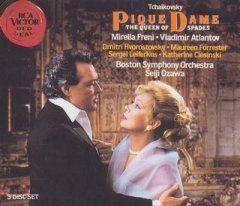Pyotr Tchaikovsky – Pique Dame (Ozawa) [1991]
Pyotr Tchaikovsky – Pique Dame (Ozawa) [1991]

1. Act I 2. Act II 3. Act III Herman - Vladimir Atlantov Lisa - Mirella Freni Graf Tomskij - Sergei Leiferkus Die Gräfin - Maureen Forrester Fürst Jeletzkij - Dmitrij Hvorostovski Pauline - Katherine Ciesinski Mascha - Dominique Labelle Boston Symphony Orchestra Seiji Ozawa - director
Based on a short story by Pushkin and fashioned into a libretto by the composer's brother Modest, The Queen of Spades was composed two years Tchaikovsky originally rejected the subject as uninspiring. A commission by the director of the Imperial Theaters, Vsevolozhsky, stirred his creative juices, however, and he finished the opera's three acts and five scenes in five months, making some changes to the libretto along the way.
The story is set in eighteenth century St. Petersburg and focuses on the young officer Gherman, who, in a public garden, confides to his gambler friend Tomsky his love for a strange young woman. Prince Yeletsky enters their company and receives congratulations on his recent engagement. The elderly Countess and her granddaughter, Liza, then enter the garden. It turns out she is the fiancée of the Prince -- and also the young woman Gherman is in love with.
Tomsky tells Gherman of the Countess' secret method of gambling, using a certain sequence of three cards that always wins. Gherman is fascinated by the story. In a meeting in Liza's room, Gherman and Liza declare their love for each other. But it is not just love that occupies the young officer's mind subsequently -- he becomes obsessed with finding out the winning three-card secret from the Countess. He goes to her quarters, but instead of learning the sequence, he frightens the elderly woman to death. Liza learns of his deed and obsession, but forgives him. In a rendezvous later by a canal, Gherman rejects her and she jumps into the canal.
The Countess' ghost reveals the gambling secret to Gherman, who then goes to the casino and wins twice with it, betting first on three, then on seven. Playing now against Prince Yeletsky, he intends to select the ace, the third of the three cards. But in his anxiety he chooses the queen of spades instead. He loses everything and stabs himself to death.
Tchaikovsky's music is interesting throughout the opera, often thoroughly absorbing. The work was written between the Fifth (1888) and Sixth (1893) symphonies, and is stylistically related to their intense emotional expressiveness and epic demeanor. The love theme here, first appearing in the second scene and again in the last, is attractive enough but does not sear into the memory like so many others by Tchaikovsky. There is a haunting melancholy theme with a descending contour associated with Gherman (in his first-scene entrance and arioso) that also seems partially to appear at the mention of the three-card sequence.
Tchaikovsky uses eighteenth century pastiche in the opera, probably more than in any other work: consider Liza and Pauline's duet, Tomsky's number in the final scene, and the Countess' "Je crains de lui," snatched from Grétry's Richard the Lionhearted. The opera is unusually dramatic and, for a Russian opera, direct and dramatic in its telling. Tchaikovsky portrays the inner lives of all the characters, including some fascinating subsidiary ones encountered on the gambling floor, with deft quick musical strokes. Although not one of the inevitably recurring operas, this fine musical drama has a secure place in the repertoire. In sum, while this opera has flaws that have kept it from the top rank of frequency of performance on opera stages outside Russia, it is rightly regarded as Tchaikovsky's best effort after Evgeny Onegin. ---Robert Cummings, Rovi
download: uploaded yandex 4shared mediafire solidfiles mega zalivalka filecloudio anonfiles oboom
Zmieniony (Sobota, 31 Maj 2014 14:26)








